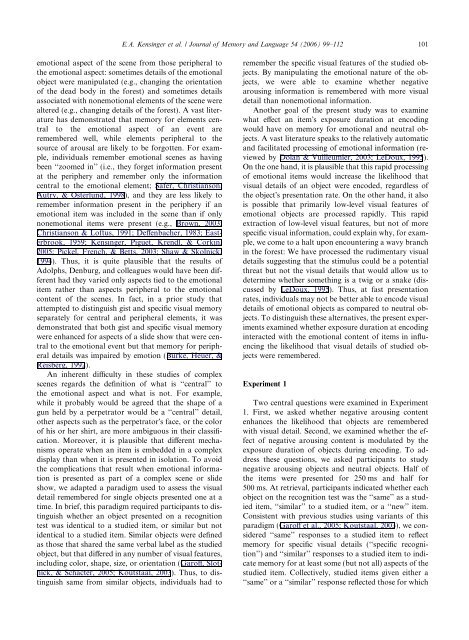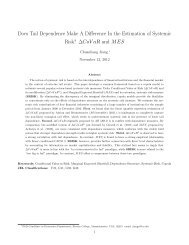Memory for specific visual details can be enhanced by negative ...
Memory for specific visual details can be enhanced by negative ...
Memory for specific visual details can be enhanced by negative ...
You also want an ePaper? Increase the reach of your titles
YUMPU automatically turns print PDFs into web optimized ePapers that Google loves.
E.A. Kensinger et al. / Journal of <strong>Memory</strong> and Language 54 (2006) 99–112 101<br />
emotional aspect of the scene from those peripheral to<br />
the emotional aspect: sometimes <strong>details</strong> of the emotional<br />
object were manipulated (e.g., changing the orientation<br />
of the dead body in the <strong>for</strong>est) and sometimes <strong>details</strong><br />
associated with nonemotional elements of the scene were<br />
altered (e.g., changing <strong>details</strong> of the <strong>for</strong>est). A vast literature<br />
has demonstrated that memory <strong>for</strong> elements central<br />
to the emotional aspect of an event are<br />
remem<strong>be</strong>red well, while elements peripheral to the<br />
source of arousal are likely to <strong>be</strong> <strong>for</strong>gotten. For example,<br />
individuals remem<strong>be</strong>r emotional scenes as having<br />
<strong>be</strong>en ‘‘zoomed in’’ (i.e., they <strong>for</strong>get in<strong>for</strong>mation present<br />
at the periphery and remem<strong>be</strong>r only the in<strong>for</strong>mation<br />
central to the emotional element; Safer, Christianson,<br />
Autry, & Osterlund, 1998), and they are less likely to<br />
remem<strong>be</strong>r in<strong>for</strong>mation present in the periphery if an<br />
emotional item was included in the scene than if only<br />
nonemotional items were present (e.g., Brown, 2003;<br />
Christianson & Loftus, 1991; Deffenbacher, 1983; Easterbrook,<br />
1959; Kensinger, Piguet, Krendl, & Corkin,<br />
2005; Pickel, French, & Betts, 2003; Shaw & Skolnick,<br />
1994). Thus, it is quite plausible that the results of<br />
Adolphs, Denburg, and colleagues would have <strong>be</strong>en different<br />
had they varied only aspects tied to the emotional<br />
item rather than aspects peripheral to the emotional<br />
content of the scenes. In fact, in a prior study that<br />
attempted to distinguish gist and <strong>specific</strong> <strong>visual</strong> memory<br />
separately <strong>for</strong> central and peripheral elements, it was<br />
demonstrated that both gist and <strong>specific</strong> <strong>visual</strong> memory<br />
were <strong>enhanced</strong> <strong>for</strong> aspects of a slide show that were central<br />
to the emotional event but that memory <strong>for</strong> peripheral<br />
<strong>details</strong> was impaired <strong>by</strong> emotion (Burke, Heuer, &<br />
Reis<strong>be</strong>rg, 1992).<br />
An inherent difficulty in these studies of complex<br />
scenes regards the definition of what is ‘‘central’’ to<br />
the emotional aspect and what is not. For example,<br />
while it probably would <strong>be</strong> agreed that the shape of a<br />
gun held <strong>by</strong> a perpetrator would <strong>be</strong> a ‘‘central’’ detail,<br />
other aspects such as the perpetratorÕs face, or the color<br />
of his or her shirt, are more ambiguous in their classification.<br />
Moreover, it is plausible that different mechanisms<br />
operate when an item is em<strong>be</strong>dded in a complex<br />
display than when it is presented in isolation. To avoid<br />
the complications that result when emotional in<strong>for</strong>mation<br />
is presented as part of a complex scene or slide<br />
show, we adapted a paradigm used to assess the <strong>visual</strong><br />
detail remem<strong>be</strong>red <strong>for</strong> single objects presented one at a<br />
time. In brief, this paradigm required participants to distinguish<br />
whether an object presented on a recognition<br />
test was identical to a studied item, or similar but not<br />
identical to a studied item. Similar objects were defined<br />
as those that shared the same verbal la<strong>be</strong>l as the studied<br />
object, but that differed in any num<strong>be</strong>r of <strong>visual</strong> features,<br />
including color, shape, size, or orientation (Garoff, Slotnick,<br />
& Schacter, 2005; Koutstaal, 2003). Thus, to distinguish<br />
same from similar objects, individuals had to<br />
remem<strong>be</strong>r the <strong>specific</strong> <strong>visual</strong> features of the studied objects.<br />
By manipulating the emotional nature of the objects,<br />
we were able to examine whether <strong>negative</strong><br />
arousing in<strong>for</strong>mation is remem<strong>be</strong>red with more <strong>visual</strong><br />
detail than nonemotional in<strong>for</strong>mation.<br />
Another goal of the present study was to examine<br />
what effect an itemÕs exposure duration at encoding<br />
would have on memory <strong>for</strong> emotional and neutral objects.<br />
A vast literature speaks to the relatively automatic<br />
and facilitated processing of emotional in<strong>for</strong>mation (reviewed<br />
<strong>by</strong> Dolan & Vuilleumier, 2003; LeDoux, 1995).<br />
On the one hand, it is plausible that this rapid processing<br />
of emotional items would increase the likelihood that<br />
<strong>visual</strong> <strong>details</strong> of an object were encoded, regardless of<br />
the objectÕs presentation rate. On the other hand, it also<br />
is possible that primarily low-level <strong>visual</strong> features of<br />
emotional objects are processed rapidly. This rapid<br />
extraction of low-level <strong>visual</strong> features, but not of more<br />
<strong>specific</strong> <strong>visual</strong> in<strong>for</strong>mation, could explain why, <strong>for</strong> example,<br />
we come to a halt upon encountering a wavy branch<br />
in the <strong>for</strong>est: We have processed the rudimentary <strong>visual</strong><br />
<strong>details</strong> suggesting that the stimulus could <strong>be</strong> a potential<br />
threat but not the <strong>visual</strong> <strong>details</strong> that would allow us to<br />
determine whether something is a twig or a snake (discussed<br />
<strong>by</strong> LeDoux, 1995). Thus, at fast presentation<br />
rates, individuals may not <strong>be</strong> <strong>be</strong>tter able to encode <strong>visual</strong><br />
<strong>details</strong> of emotional objects as compared to neutral objects.<br />
To distinguish these alternatives, the present experiments<br />
examined whether exposure duration at encoding<br />
interacted with the emotional content of items in influencing<br />
the likelihood that <strong>visual</strong> <strong>details</strong> of studied objects<br />
were remem<strong>be</strong>red.<br />
Experiment 1<br />
Two central questions were examined in Experiment<br />
1. First, we asked whether <strong>negative</strong> arousing content<br />
enhances the likelihood that objects are remem<strong>be</strong>red<br />
with <strong>visual</strong> detail. Second, we examined whether the effect<br />
of <strong>negative</strong> arousing content is modulated <strong>by</strong> the<br />
exposure duration of objects during encoding. To address<br />
these questions, we asked participants to study<br />
<strong>negative</strong> arousing objects and neutral objects. Half of<br />
the items were presented <strong>for</strong> 250 ms and half <strong>for</strong><br />
500 ms. At retrieval, participants indicated whether each<br />
object on the recognition test was the ‘‘same’’ as a studied<br />
item, ‘‘similar’’ to a studied item, or a ‘‘new’’ item.<br />
Consistent with previous studies using variants of this<br />
paradigm (Garoff et al., 2005; Koutstaal, 2003), we considered<br />
‘‘same’’ responses to a studied item to reflect<br />
memory <strong>for</strong> <strong>specific</strong> <strong>visual</strong> <strong>details</strong> (‘‘<strong>specific</strong> recognition’’)<br />
and ‘‘similar’’ responses to a studied item to indicate<br />
memory <strong>for</strong> at least some (but not all) aspects of the<br />
studied item. Collectively, studied items given either a<br />
‘‘same’’ or a ‘‘similar’’ response reflected those <strong>for</strong> which

















